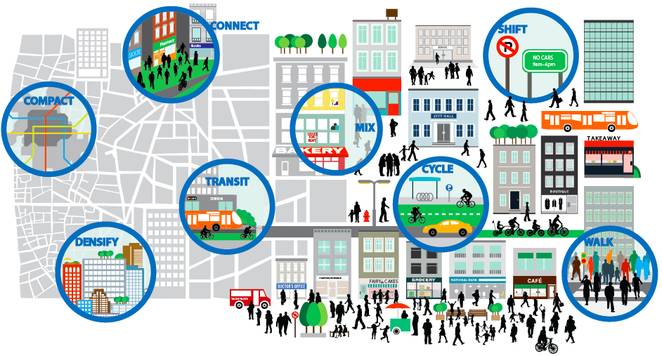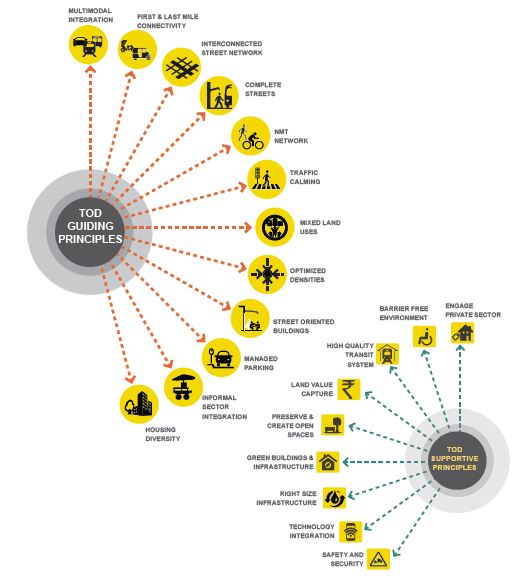Connecting India – Moving People, Not Just Vehicles
Understanding Opportunities for Transit Oriented Development

Recently NITI Aayog, proposed a three year Action Agenda document, recommended certain policy changes which will allow us to better align the development strategy with changed reality of India. One such reality is the exponential rate at which urbanization is taking place in India.
The three years Action Agenda for Urban Development apart from discussing existing programmes of urban development. It also suggests additional measures for speeding up the progress in different aspects of urbanization. One such suggestion relates to the field of urban transportation. The document observes that transport is one of the key determinants of comfortable city life.
Apart from providing mobility to people and goods, urban transport provides access to employment, education, shopping, health, entertainment opportunities.

The On-going Efforts
Ministry of Urban Development, Government of India, (MoUD) is promoting a new planning paradigm – providing technical support and guidance, exposing the cities to best practices of urban transportation. Our commitment is reflected in every programme being pursued at MoUD.
Atal Mission for Rejuvenation & Urban Transformation (AMRUT) which covers about 500 towns and cities across the country, besides other services, identifies development of pedestrian, non- motorized and public transport facilities as thrust areas for investments.
Under Smart Cities Mission one of the core infrastructure elements identified is efficient urban mobility and public transport, with focus on smart parking, intelligent traffic management and integrated multimodal transport. The Mission envisages comprehensive development in cities – creating walkable localities and promoting a variety of transport options including Transit Oriented Development (TOD), public transport and last mile para-transport connectivity.
Further, to effectively address the growing problems of pollution, congestion and shortage of housing stock the MoUD is in process to come out with a multi-pronged policy framework to promote living close to mass urban transit corridors. This new initiatives seeks to promote ‘Transit Oriented Development (TOD)’ which enables people to live within walking or cycling distance from transit corridors like the Metros, Monorail and Bus Rapid Transit (BRT) corridors.
Transport Oriented Development (TOD)
Under TOD, city densification will be promoted along mass transit corridors through vertical construction by substantially enhancing FARs (Floor Area Ratio) backed by promotion of Non-Motorised Transport infrastructure for walking and cycling to transport stations, development of street networks in the influence zone of transit corridors, multi-modal integration, effective first and last mile connectivity through feeder services to enable people access public transit in 5 to 10 minutes from home and work places.
The focus under TOD policy would be to promote integration of land use planning with transportation and infrastructure development to avoid long distance travel in cities through compact development as against the present pattern of unplanned and haphazard urban growth.
Transit Oriented Development will be financed by channelizing a part of increases in property values resulting from investments in transit corridors through Betterment Levies and Value Capture Financing tools. Increased private sector participation will result in economic development and employment generation.

Incentive for Implementation
This new urban design and planning in the form of TOD, is being incentivised by the Ministry under two more initiatives viz., Metro Policy and Green Urban Mobility Scheme. Under the new Metro Policy, TOD has been made mandatory while under Green Urban Mobility Scheme, TOD has been made an essential reform and is given priority for receiving central assistance.
As per a study by Centre for Transit Oriented Development (CTOD) Chicago, TOD produces 43 percent less emissions than conventional suburban development. Further, various global cases and research literature proves that the TOD enhances assessed value of land by 81 percent in 10 years; 50 percent of residents take transit to work of which 73 percent walk to stations.
Conclusion
The time is opportune to structure an approach to address how integrated land use and transit may serve as a tool to bring about the paradigm shift and assist in transforming the future of Indian cities.





